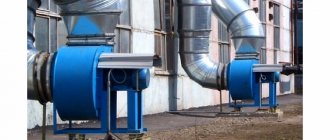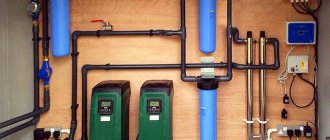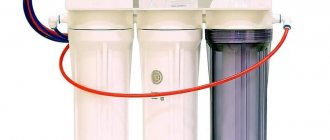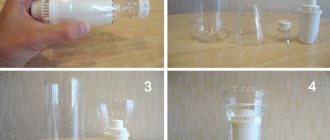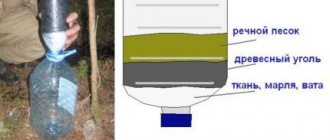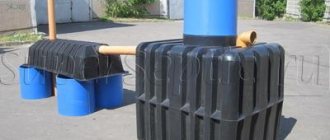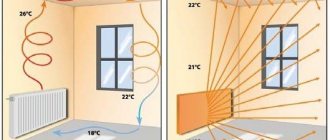The use of precipitation will provide significant savings in water extracted from a well or well. In addition, it will help reduce energy consumption, as it allows you to turn on pumping equipment less often. However, you don’t know how to collect nature’s free “gift” for further use?
We'll show you how to do this. The article discusses a rainwater collection system and options for using precipitation for domestic needs. The device, design specifics are described, and the effectiveness is assessed taking into account the funds spent on organizing an alternative water supply.
For interested visitors, we have selected organizational diagrams with underground and above-ground reservoir locations, presented photos with options for masking the storage tank, and collected useful videos that allow you to organize water collection on your own.
Types of storage systems
To daily serve the needs of people permanently living in a country house, from 130 to 160 liters of water per person are required. A lot of life-giving moisture is spent on watering beds, garden trees, flower beds and lawns. The water collection method is also beneficial because the liquid has time to warm up and settle. It is best to water crops with this water.
In many ways, the choice of tanks that collect rainwater depends on the method and location of collection. If it is collecting rainwater from the roof, then a barrel, trolley or any plastic tank will do. For underground installations, it is best to choose heavier structures - made of concrete, steel, iron alloy with galvanized coating.
Minuses! Complete dependence on the volume of rainfall. If a dry summer sets in and there is no running water on the site, then a well or borehole will serve as an additional source.
Boxes for storing rainwater, drainage and water pipes made of plastic Source prepperology.net
Storage container
Regardless of how the accumulated food will be used in the future, it is best to collect it in a container made of food materials.
They are environmentally friendly and, most often, not transparent - which is an invaluable characteristic, since it extends the shelf life of the resource.
Creating your own rainwater collection system
One of the main advantages of using your own reservoir is minimal cash investment at the start and zero financial costs during operation. It is enough to purchase pipes, connecting elements, fasteners, sealants and containers.
Operating principle of the double filtration system:
- From the waste pipe, water passes through an external filter installed in the first tank.
- Purified water flows through the pipe into the second tank, undergoing filtration there too.
- Through a submersible pump, clean water enters the hose and onto the beds (water pipe, and then to consumption points in the house).
A universal filter (POT filter) can be attached to the branch pipe of the storage tank, at the junction with the drainpipe.
Correct roofing
The configuration of the roof structure influences the design of the catchment point. And the type of roofing material affects water quality. We immediately exclude flat roofs for two reasons:
- Lack of natural drainage.
- Stagnant puddles are a breeding ground for bacteria.
The ideal option would be single-pitched, two-, three-, hipped roofs. The larger and steeper the slope the structure has, the faster water will flow over its surface.
The gable roof of the barn serves as an excellent place to collect rainwater Source forum-wec.com
Harmless roofing material:
- clay tiles;
- galvanized sheets;
- plastic (gutters and downpipes);
- bitumen (is relatively safe).
Precaution! Rainfall cannot be collected from roofs covered with tiles containing copper. It is also not recommended to cover the roof from which you plan to receive rainwater with asbestos slate or lead alloy sheets. The listed materials are harmful to human health and some plants.
Features of installing water collectors
Several types of installation of a water storage tank - on the ground under roof gutters, in the basement of a house, an extension, a utility room, buried in the ground away from a residential building. For the last option, take larger containers - from 2 to 3 thousand liters.
Placing the tank in the ground:
- Dig a pit larger than the container.
- The bottom of the pit is covered with a cushion of sand - 20 cm thick.
- A concrete platform with built-in metal hinges is poured. But you can put a ready-made reinforced concrete slab.
- Clean the surface from crushed construction debris and stones.
- Install the container.
- Using cables, the tank is attached to a concrete slab. This is necessary so that it does not “float up”.
- Connect pipes (sink, water), a pump, and a water level control sensor to the tank.
- The rest of the space in the pit is filled and compacted with sand.
- The neck of the container remains above the ground. It needs to be closed with a lid.
Installation of storage tanks in the ground for water from the roof and primary filtration Source bio7active.com
Consequences of condensation
The constant presence of moisture on the surface of the drain tank is not only a small nuisance - it is a big problem, which in a few years can cause a lot of discomfort for the safe living of the family.
This is fraught with the following consequences:
- The microclimate is deteriorating;
- condensation promotes corrosion on metal elements;
- any cosmetic repairs made with expensive materials will be reduced to zero due to prolonged exposure to moisture;
- Mold and mildew will appear in the room.
And if you leave the bathroom unattended for a long time, then puddles formed from condensation can penetrate to the neighbors on the lower floor. And this threatens not only damaged relations with them, but possible financial expenses for repairs.
Purpose of rainwater on the farm
The only case when atmospheric flows will be harmful for use in the housing stock is rain falling in an area near which a chemical plant or some kind of man-made production is located. This point also applies to areas near megacities. Otherwise, rainwater is the best substitute for tap water.
The main purpose of collecting rainwater when used in a country house or suburban area:
- watering plants - a large accumulation of oxygen in water makes it ideal for feeding crops;
- technical needs - washing tools, equipment, cars, paved areas and garden paths;
- household use - washing, cleaning, washing dishes, hygiene procedures;
- organization of a summer shower - installation above the cabin;
- coolant for heating - water flows from the storage tank into the heating tank, and from there to the points of consumption (radiators and pipes).
Rainwater from an underground reservoir was used for irrigation and communications in the house Source abitare.com
Western approach - not a bit of a waste
In the West, the process is taken to the highest level. Residents of highly developed countries, in a technological sense, such as Germany, Holland and others, do not waste water from wells on toilets and other small household needs.
They consider the heavenly office to be an excellent resource provider for these purposes. This approach allows you to save money on pumping equipment and the electricity required for its operation.
Useful tips
It will be easier to monitor the volume of accumulated liquid if you use a special sensor for this. The device is connected to the reservoir, part of it is placed inside the cavity. The device notifies you with a signal from time to time when the barrel is full. This is very convenient when constructing an underground reservoir or in cases where the container is located high above. It is better to place the pump not at the bottom inside the container, but higher, where there is no layer of sediment. This method will eliminate clogging of the equipment and will give it the opportunity to last longer.
As soon as it starts to rain, it is better to disconnect the system from the drainpipe. You need to let the dirty water and leaves drain into the soil. The holding time of the container depends on the intensity of the rain. If the flow is strong, it will wash away dirt from the roof in a few minutes. Then you can connect the system to the drain. This method is used during periods of rain that come after a long drought. Coarse filters installed at the bottom of the drainpipe will help protect against large blockages.
The pump should be immersed in the upper waters; as water is drawn, it is lowered slightly Source planetainstrument.ru
Mosquitoes
Warmth and stagnant water are the favorite habitats of mosquito larvae and adult blood-sucking insects. To prevent the infestation of mosquitoes, midges (black midges) and other types of harmful winged insects, use hermetically sealed lids of cases and reservoirs with collected rainwater. The most optimal types of temporary plugs are covers with a threaded connection.
What is drainage
The purpose of the drainage system is to collect excess moisture from the soil, that is, to drain it. The task of the system is to prevent an excessive rise in the groundwater level so that the site does not turn into a swamp. Most often, drainage is done on swampy soils.
The way to check the humidity level is to dig a hole half a meter deep in any area of the dacha. If after a short time (without rain) water accumulates there, you need to build a drainage system. Otherwise, the water will begin to wash away and destroy the foundation of all buildings.
Types of drainage
There are surface and deep drainage sewers.
The first option has two subtypes:
- Linear system. Trenches are dug on the soil surface along the entire perimeter of the site. Snow and rainwater flows into the depressions. The network works on flat surfaces without sudden changes in height. The depth of the trenches is up to 30 cm, the bottom and walls are covered with fine gravel. Advantages: simplicity and efficiency of arrangement. The downside is the need to clean the ditches from debris.
- Point drainage. The simplest type is to install water collectors at points where liquid drains abundantly. These can be drains, natural depressions in the soil. Barrels are placed under drains, and in ravines open containers are buried in the ground.
Expert opinion Vladislav Ponomarev Design engineer, inventor
To form surface drainage, no complex calculations are made. The system is equipped “by eye”.
Deep drainage is a complex network of channels and pipelines that drains moisture into special structures or ditches outside the site. Sewerage is carried out with preliminary accurate calculations in accordance with geological survey data. Deep drainage is required in areas with sharp changes in relief and abundant groundwater at shallow depths.
Loading …
Service
The water barrel needs to be properly prepared for winter. It is important to clean out all silty deposits. If this is not done, then the dried plaque will freeze and form a fraction that is difficult to remove. A container with overwintered silt becomes unsuitable for watering the garden, in domestic conditions, and even for technical needs.
Clusters are harmful bacteria. They can infect the garden, flower beds, and gardens with pathogens. A washed car will be covered with unpleasant stains. And harmful fumes will be released from garden paths, terraces or gazebos washed with muddy water.
The equipment servicing the tank also needs to be prepared for cold weather. After collecting rainwater from the roof and filling the container sufficiently, the pump is removed, cleaned and stored in a dry place. The tank lid is tightly sealed and covered with sand or soil on top. The layer thickness is from 30 cm. These measures will protect the pumping unit, tank and water in it from freezing.
Bosch cable is one of the best cleaners for a clogged drainpipe Source oboiman.ru
Bacterial safety
Bacterial safety is an important factor for the use of process water. Work on disinfecting the liquid takes place at the last stage, after filtering from all mechanical impurities.
There are two methods used to purify rainwater from bacteria:
- Chemical. Installation of special disinfection cartridges.
- Disinfection using ultraviolet systems (Figure 8).
Figure 8. Ultraviolet rainwater disinfection systems
Urban rooftop farm on an industrial scale
Details Created on 08/25/2013 09:50
Written by Natali
A few years ago, the idea of a large-scale commercial urban farming operation that could provide locally produced food seemed impossible. Increasingly, urban farms or “rooftop farms” have appeared on the roofs of high-rise buildings, municipal buildings or just small residential buildings, helping people get the fresh fruits and vegetables they need and pleasant coolness during the hot season.
This business development model seemed very attractive to the agricultural company Lufa Farms and now it is opening its second, largest to date, urban farm north of Laval, Canada.
The farm is located on the roof of a building that houses a furniture store and other commercial tenants, and occupies 4,000 square meters.
Articles tagged
Micro-house Ecocapsule enters the market
Details Created on 02/09/2018 13:28
Written by Natali
Facepla.net has been following the Ecocapsule solar and wind micro-home since the prototype stage. Now, almost 10 years after the fantastic concept was conceived, its Bratislava-based designers are finally making their international debut with the exclusive release of 50 off-grid micro-homes that can be installed almost anywhere.
While this set of smart, self-sufficient tiny homes will only be available to customers living in the United States, Japan, Australia and the EU, a second production series will follow in late 2018.
Articles tagged
How to organize water drainage on the site
This task is complex; it includes systems that complement each other:
- drainage system;
- surface drainage system;
- drainage system.
Using the first two systems, rain and melt water can be drained away. These types of groundwater are seasonal and pose a significant problem for houses with a basement. In addition, they can instantly fill a cesspool during floods.
If there is a roofing system, rainwater quickly accumulates and is drained to the catchment area. If there is no drainage, then very soon the rains will simply break the steps, blind area and all the paths near the building. The remaining melt and storm water is eliminated using surface drainage.
If the basement is flooded with water, and at the same time the cesspool needs to be pumped out weekly, then deep drainage will have to be performed.
